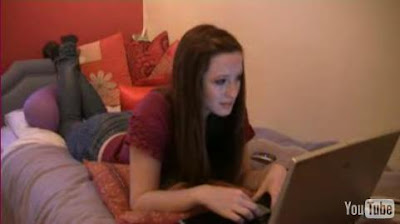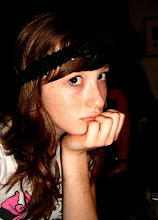When starting to look at different film
genres in preparation for starting our group piece, we looked at different film genres and the conventions of each of those genres. For example rom-com would be very high key (lighting) and would usually had younger attractive people falling in love, with a struggle s
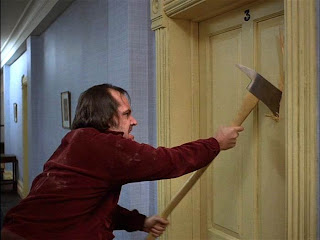
eparating them. Then there was drama; using fast paced editing and lots of action to keep the audience enticed. Then we began to look at horror and thriller and as we did this we focussed deeper and deeper in on it, realising this is probably what we would want to choose for our own genre. And we did. The
horror/thriller crossover share many common conventions such as a dark environment (often) with a main murderer, and a main victim (or possible victim). Some of the common
themes of horror are death, victims, as well as the conventions of the production such as ominous music, and editing or creating a story which itself creates and enigma for the audience: leaving them guessing. Two examples of this are Hitchcock’s
‘Psycho’ (1960) as well as
‘The Shining’ (Kubrick, 1980) as well as many others. Both films holdback information until the end so the audience are more intrigued and, ultimately, more scared. We generally fit to these conventions of the horror thriller genre by having the classic characters of a ‘victim girl’ and a ‘nasty
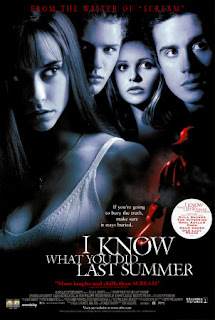
murderer’, as well as using enigmas, by not showing the murderers face until the third thing he says, and having him sign in at the very beginning as ‘Julie’ making audiences believe him to be a woman. We used
iconography similar to that of other horror films. These included the location; a dirty cellar and the lighting; low key and shadowy. Another way we represented the genre of a horror/thriller is that we used the theme of stalking, which has been used is film such as
‘I Know What You Did Last Summer’ (Gillespie, 1997). We also used chilling music such as an ominous drone. In our audience feedback it showed that they all thought it was horror/thriller, so it shows that sticking to the conventions works well.
However to be more creative we didn’t stick rigidly to conventions, for example, we used a modern but still twisted storyline, involving the internet, and we also had two murderers which is uncommon in most horror films. We also used a modern piece of music which sounded like a dial-up internet connection to continue our particular theme. We stuck to most of the old forms and conventions of horror with modern twists to it, such as its modern context of meeting people over the internet. We didn’t choose to stick to Todorov’s
classic narrative pattern of staring with an equilibrium, with a disruption that eventually gets resolved, because we felt it made more of an impact on the audience to start with disruption.
We also had to look at the
conventions of an opening sequence in order to create a film that was accurate in content and in its production
Conventions include:Introduction to key characters (Elle in Legally Blonde, Luketic 2001)
Titles throughout
Music (Shining)
Info on what is to come (Magdalene Sisters, Peter Mullen 2004)
Main themes of the film (killers obsessive record keeping in Seven, Fincher 1995)
Visual references to the title (pumpkins in Halloween, Carpernter 1978)
Sense of danger from the offset-only for horror (Seven starts with a dead body)
Symbolic/iconic images
We stuck to all these conventions I believe as we introduced our murderers (the girl was merely the first victim), we had titles throughout and music, introduced the main theme of the internet and gave an insight into what was to come. We have used many narra tive techniques in our sequence such as editing it in real time, using cross-cutting, and a small ellipsis between bits in the conversation. Some of our action and enigmas codes include our montage sequence at the end, and the enigma is when you can hear the printer sound but are unsure as to who is printing it. We used the classic characters roles from horror films such as the victim, insignificant to the overall plot but just one to add to the body count. In our film she is a girl like most horror films including ‘Scream’ (Craven 1996). The overall style of our piece is very eerie, with close-up camera work to show the expressions of both murderer and victims face, be it scared or smug. Our sequence has continuity such as match-on-action and shot reverse shot, however breaks this by having a montage at the end.
tive techniques in our sequence such as editing it in real time, using cross-cutting, and a small ellipsis between bits in the conversation. Some of our action and enigmas codes include our montage sequence at the end, and the enigma is when you can hear the printer sound but are unsure as to who is printing it. We used the classic characters roles from horror films such as the victim, insignificant to the overall plot but just one to add to the body count. In our film she is a girl like most horror films including ‘Scream’ (Craven 1996). The overall style of our piece is very eerie, with close-up camera work to show the expressions of both murderer and victims face, be it scared or smug. Our sequence has continuity such as match-on-action and shot reverse shot, however breaks this by having a montage at the end.




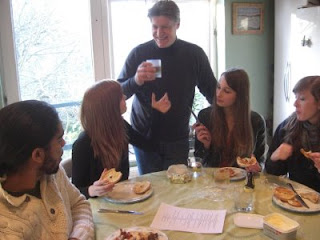


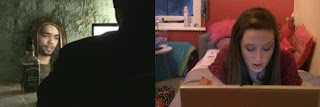


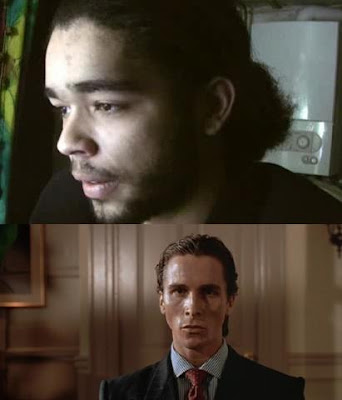 The other murderer was also tall and dressed all in black to look menacing. He is wearing a beanie which fits in with the more ‘classic’ thug/murderer appearance. He was putting knifes and other equipment into a briefcase, showing he is the more violent one and that the one on the computer is more charming.
The other murderer was also tall and dressed all in black to look menacing. He is wearing a beanie which fits in with the more ‘classic’ thug/murderer appearance. He was putting knifes and other equipment into a briefcase, showing he is the more violent one and that the one on the computer is more charming.